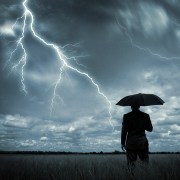 Photo: Getty Images
Photo: Getty Images
As a little girl, I was always fascinated by lightning, and would crawl out of bed and open my window to hear and see the storm. Dark thunder clouds literally become charged with electricity. When that electricity decides to jump out of the cloud, we see the lightning flash and hear a noise we know as thunder. This event of nature is so extraordinary, scientists can’t even agree on what causes the clouds to become electrically charged in the first place.
It wasn’t until a storm ended one of my nephew’s baseball games that I realized this beautiful phenomenon can also be a very real danger. That day at the baseball field, the sky had clouded over, but it had not started to rain. The umpire, as soon as he saw the threatening sky, ended the game. He explained to us that a dugout is not a safe place for kids if lightning is overhead.
The statistics show that the umpire was not over-reacting when he got us off the field that day. According to the National Weather Service (NWS), lightning kills an average of 55 Americans each year and permanently injures hundreds of others. Even more troubling, a person who survives a lightning strike can experience depression, memory loss, or attention deficit; the list of ailments goes on and on.
How do we keep our families safe from lightning this summer and all year? NWS advises: When Thunder Roars, Go Indoors. Seek shelter in a substantial building or car. Remember to stay away from the bathroom and electrical equipment until the storm has passed. When boating or swimming, find shelter immediately on land. If you are out in the open, crouch down into a small ball, and touch the ground with as little of your body as possible. The NWS also reminds us that open garages, carports, picnic shelters, tents, golf carts, and convertibles are not safe places to seek shelter from lightning. If a member of your family is struck by lightning, call 911 and begin CPR. Victims of a lightning strike are not electrically charged and are safe to touch.
Since death and injuries from lightning spike during the summer months, I encourage you to talk to your children and discuss a family plan so everyone is safe while enjoying the great outdoors this summer.
Sources:
http://www.lightningsafety.com/nlsi_pls.html
http://www.lightningsafety.noaa.gov/
http://science.nasa.gov/science-news/science-at-nasa/1999/essd18jun99_1/
Reviewed July 5, 2011
by Michele Blacksberg R.N.
Edited by Alison Stanton






Add a CommentComments
There are no comments yet. Be the first one and get the conversation started!